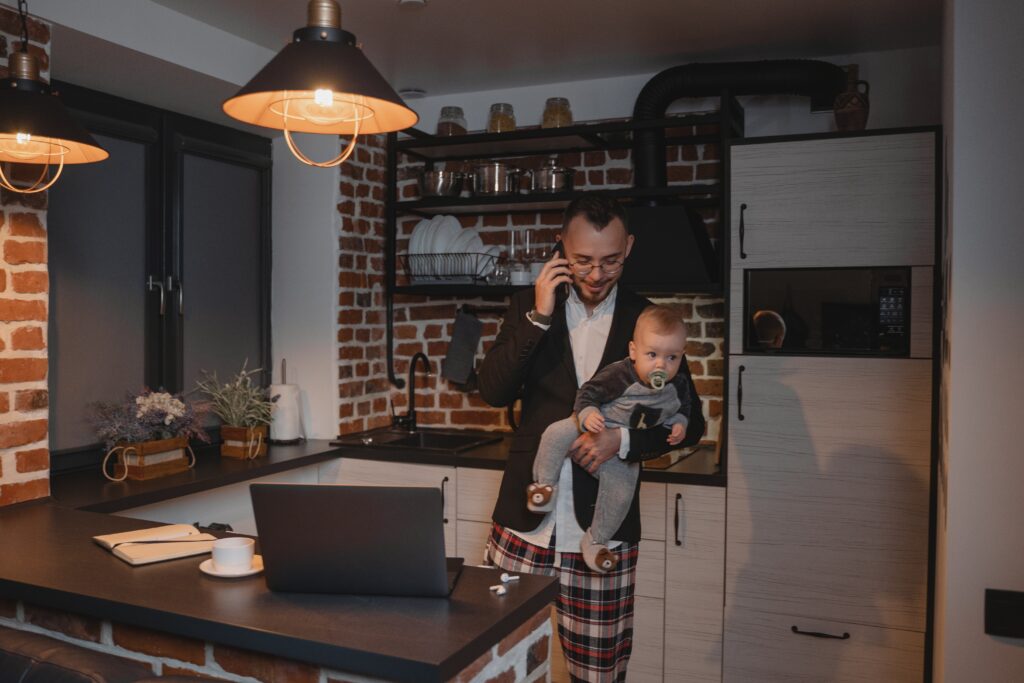The pandemic changed the world of work – and change is here to stay.
The UK government and devolved administrations responded to the COVID-19 crisis in 2020 by imposing lockdowns, stay-at-home orders and travel bans and restrictions.
No business has been unaffected. Some industries shut down entirely, while others – from vast corporations to small businesses – switched to fully remote working for the first time ever. Even businesses allowed to remain open saw profound operational changes, with changes to opening hours, and enforcement of social distancing and mask wearing.
Needless to say, it has been a time of disruption, however when it comes to the world of office-based work, many believe that the pandemic has merely accelerated inevitable digital transformation.
Zoom, Skype, Google Hangouts, Microsoft Teams – these were all being utilised for business before the pandemic. The same goes for cloud computing, allowing teams to have shared online access to files, folders and documents.
Software as a Service (SaaS) has been growing steadily over the past decade, offering numerous digital tools for business operations.
We have online staff portals, online email login, online tax returns, online MOT bookings… the list goes on.
Digital transformation of the workplace
According to PWC’s 2021 annual CEO survey, 77% of business leaders plan to invest in digital transformation. The survey authors state: “During the pandemic, most organisations found technology and digital channels were critical to survival. Those organisations that had already prioritised digital transformation fared better and are now the example others are seeking to emulate.”
Kenny Wilson, CEO of Dr Martens, says: “Even before the pandemic, we were committed to reaching consumers by digital first. That was a conscious strategy that started playing out in 2018, and I’m glad it did because when we hit the pandemic we were able to be flexible and adjust the company. You could see the market was heading that way but the pandemic sped everything up.”
It makes sense that retailers want to maintain the new, expanded or improved online shopping options they’ve developed to cope with lockdown. However, shoppers aren’t the only ones who want to hang on to the pandemic’s silver linings. Many studies show that most office workers want to retain the option to spend some of their working week at home.
Flexible working
Speaking in March 2021 at the EPOS virtual conference, The New Age of Hybrid Work, Marla Arnall, Asia Consulting Leader at Mercer said “Prior to the pandemic, two thirds of companies offered flexible working policies, but only one third of employees felt comfortable requesting those.” Arnall says the pandemic has acted as an “equaliser” – seeing companies successfully operating remotely makes employees feel more comfortable about asking for flexibility.
The Chartered Institute of Personnel and Development (CIPD) produced a report entitled Working from home: assessing the evidence. This report states: “only 50% of respondents to one survey said their manager was supportive of homeworking before lockdown, but this rose to 90% during lockdown.”
Staff have reported that working from home has improved their mental and physical wellbeing. The CIPD cites a number of studies which showed home working cuts absenteeism and improves productivity.
There are a number of possible reasons for this:
- Without a lengthy commute, people can start their day later and in their own way, arriving at their desks rested and ready to work. They also save money.
- People too ill to come into the office (or self-isolating due to a close contact) may still be well enough to work from home. Essential appointments can be scheduled in lunch breaks and throughout the day, without the usual requirement for permission or time away from work.
- Without the usual distractions and interruptions of a shared office environment, people can focus better and get more done.
- Being trusted to work from home and manage their own workloads and deadlines is empowering and motivating.

Work / life balance
Not everyone has thrived working from home. The CIPD report lists social isolation, distractions, lack of proper workspace, childcare challenges and work-related communication issues as some of the key problems people have faced in working from home full-time.
Dr Ethan Lim, Head of Clinical & Wellness at Cigna Singapore told the EPOS conference about some of the downsides of full-time home working.
“Being stuck at home affected mental health due to reduced social interactions. Adapting to a new environment is stressful. This shift in how people go about their daily lives left many feeling lost. In finding a work/life balance, some of us need to be able to segregate our time or separate our home and work environments. Some people do not adapt very well to being in one place for a long time.”
The “working from home” we’ve seen imposed on half of the working population during lockdown is very different from what flexible or remote working usually looks like.
Working from home five days a week, possibly with children at home to look after, and other adults attempting to work from home has been less than ideal for many people.
For others, it has improved productivity and allowed them to fit their work around their life in a way that better suited them.
No going back?
The general consensus is that hybrid working is here to stay. Fujitsu’s No Going Back report found only 18% of employees want to return to the office full-time, and that 85% of business leaders and 71% of employees believe hybrid working “will make their organisation more resilient and better equipped to survive economic issues”.
Fujitsu states: “Hybrid working is emerging as the strategy of choice for large organisations where the option of remote working is viable in the longer-term. Gartner predicts that social distancing in offices will cut office capacity to 40% and 30% of organisations will consider downsizing office space by the end of 2021.”
Big brands are already leading the way. British Airways have announced they will allow staff to split their work time between home and the office after the pandemic. BP staff will work from home two days a week after lockdown lifts. IBM expects 80% of its staff to work in “hybrid roles” post-pandemic, working around three days a week in the office.
If you’re considering a hybrid model, here are the key considerations:
Challenges
Security
Data protection and cyber security are obvious concerns when it comes to allowing staff to work from home.
The PWC survey shows 91% of CEOs are concerned about cyber security threats and vulnerabilities (up from 80% last year).
Marco Amitrano, Head of Clients and Markets at PwC UK, says: “In a period of disruption, where the role of technology has been more critical than ever, so is digital transformation. And acting to protect your business from cyber attack, when it relies more than ever on technology, is perhaps the epitome of a ‘no regret’ move.”
Good cyber hygiene includes ensuring secure authentication and access – multi-factor authentication and digital certificates are must-haves.
Make sure your information governance policy is extensive and robust. There should be clear processes to follow on how to treat all data – paper-based and digital.
Investing in company laptops and robust data encryption measures is a wise move.
Communication and isolation
Multiple surveys and studies showed that staff missed both the social and the work-related face-to-face interactions with their colleagues. While hybrid working means a split between office and home, it’s still important to make sure remote-working employees feel connected to and valued by the companies they work for.
Although the stats show that flexible working boosts productivity, it needs to be supported. This means putting systems and processes in place to ensure homeworkers can:
- Collaborate effectively with office colleagues
- Receive appropriate supervision and support from line managers
Wellbeing
One benefit of leaving your home to go to a workplace is that it provides clear separation between work and your personal life. Even staff who embrace flexible working may struggle to maintain a healthy work/life balance. Fitting their work around their day may make it more difficult to decide or realise that the work day is over.
Safety is also an important concern, with incidences of domestic abuse rising in the lockdown and pandemic period.
Again, regular communication with homeworkers will be important. Support them in maintaining healthy working hours, and encourage them to create ‘shut-down’ procedures to transition from work to leisure time.

Opportunities
Staff morale
Managed well, flexible working can significantly increase staff morale and motivation.
Being trusted to do their job well without physical supervision, having control over the structure of their working day, and reducing time and money spent commuting – these are all things which can help staff to feel empowered, and research shows it boosts productivity.
Happier staff aids staff retention, reducing staff turnover, which can boost the company’s reputation, in the eyes of potential employees as well as prospective clients.
Agility
Fortunately, JT Maxwell had a business continuity plan and when it looked like lockdowns were on the way last year, we began putting it into place and quickly transitioned to remote working.
Lockdowns forced the hand of many companies in terms of managing staff working from home, in what Fujitsu calls the “burning platform” of the pandemic. Companies had to ‘jump’ from office working to remote work, whether they had prepared or not.
Now that it’s been done and lessons learned, hybrid working potentially offers an opportunity for businesses of all sizes to operate in a continuous state of readiness.
British Airways are exploring the sale of their huge Waterside HQ building, previously the workplace of around 2,000 employees. It’s a demonstration of another trend emerging – businesses freeing themselves from the cost of fixed overheads by embracing flexibility in their office spaces too.
The Global Coworking Growth study published in 2020 predicts that five million people will be using a co-working space by 2024 – a whopping 158% higher than the number using them in 2020.
Co-working spaces may offer an affordable and responsive alternative to traditional commercial leases for businesses embracing the agility of hybrid offices.
Diversity and inclusion
Removing barriers to remote or flexible working could (and should) create new employment opportunities for those who aren’t able to work full-time from a designated workplace, such as disabled people, people with chronic illnesses or long-term health conditions, carers, working mothers, and single parents.
Previously, these groups have struggled to convince employers that their jobs could be done effectively, efficiently and securely from home. Lockdowns have demonstrated exactly how feasible remote working is. Widening the choice of prospective employees is only a good thing, and making the workplace more inclusive is an important factor of good corporate responsibility.

We’d love to hear from you – are you doing things differently in your office due to the pandemic? If so, will any of these changes remain or are you committed to returning to pre-covid normality? Maybe you’re still deciding what’s best?
We are keen to keep the conversation going, and ideally, provide support and information to those who need it. Drop us an email to info@jtmaxwell.co.uk entitled ‘Hybrid article’ or share your thoughts on our hybrid office posts on Facebook, Twitter, Instagram and Linked In.




